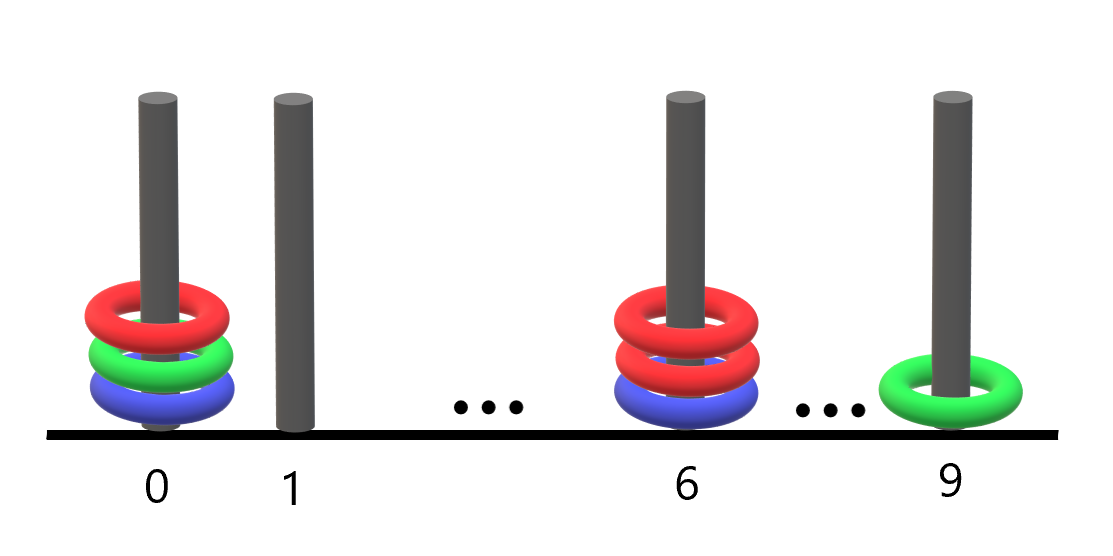Welcome to Subscribe On Youtube
2103. Rings and Rods
Description
There are n rings and each ring is either red, green, or blue. The rings are distributed across ten rods labeled from 0 to 9.
You are given a string rings of length 2n that describes the n rings that are placed onto the rods. Every two characters in rings forms a color-position pair that is used to describe each ring where:
- The first character of the
ithpair denotes theithring's color ('R','G','B'). - The second character of the
ithpair denotes the rod that theithring is placed on ('0'to'9').
For example, "R3G2B1" describes n == 3 rings: a red ring placed onto the rod labeled 3, a green ring placed onto the rod labeled 2, and a blue ring placed onto the rod labeled 1.
Return the number of rods that have all three colors of rings on them.
Example 1:

Input: rings = "B0B6G0R6R0R6G9" Output: 1 Explanation: - The rod labeled 0 holds 3 rings with all colors: red, green, and blue. - The rod labeled 6 holds 3 rings, but it only has red and blue. - The rod labeled 9 holds only a green ring. Thus, the number of rods with all three colors is 1.
Example 2:

Input: rings = "B0R0G0R9R0B0G0" Output: 1 Explanation: - The rod labeled 0 holds 6 rings with all colors: red, green, and blue. - The rod labeled 9 holds only a red ring. Thus, the number of rods with all three colors is 1.
Example 3:
Input: rings = "G4" Output: 0 Explanation: Only one ring is given. Thus, no rods have all three colors.
Constraints:
rings.length == 2 * n1 <= n <= 100rings[i]whereiis even is either'R','G', or'B'(0-indexed).rings[i]whereiis odd is a digit from'0'to'9'(0-indexed).
Solutions
Solution 1: Bit Manipulation
We can use an array $mask$ of length $10$ to represent the color situation of the rings on each rod, where $mask[i]$ represents the color situation of the ring on the $i$th rod. If there are red, green, and blue rings on the $i$th rod, then the binary representation of $mask[i]$ is $111$, that is, $mask[i] = 7$.
| We traverse the string $rings$. For each color position pair $(c, j)$, where $c$ represents the color of the ring and $j$ represents the number of the rod where the ring is located, we set the corresponding binary bit of $mask[j]$, that is, $mask[j] | = d[c]$, where $d[c]$ represents the binary bit corresponding to color $c$. |
Finally, we count the number of elements in $mask$ that are $7$, which is the number of rods that have collected all three colors of rings.
The time complexity is $O(n)$, and the space complexity is $O(|\Sigma|)$, where $n$ represents the length of the string $rings$, and $|\Sigma|$ represents the size of the character set.
-
class Solution { public int countPoints(String rings) { int[] d = new int['Z']; d['R'] = 1; d['G'] = 2; d['B'] = 4; int[] mask = new int[10]; for (int i = 0, n = rings.length(); i < n; i += 2) { int c = rings.charAt(i); int j = rings.charAt(i + 1) - '0'; mask[j] |= d[c]; } int ans = 0; for (int x : mask) { if (x == 7) { ++ans; } } return ans; } } -
class Solution { public: int countPoints(string rings) { int d['Z']{['R'] = 1, ['G'] = 2, ['B'] = 4}; int mask[10]{}; for (int i = 0, n = rings.size(); i < n; i += 2) { int c = rings[i]; int j = rings[i + 1] - '0'; mask[j] |= d[c]; } return count(mask, mask + 10, 7); } }; -
class Solution: def countPoints(self, rings: str) -> int: mask = [0] * 10 d = {"R": 1, "G": 2, "B": 4} for i in range(0, len(rings), 2): c = rings[i] j = int(rings[i + 1]) mask[j] |= d[c] return mask.count(7) -
func countPoints(rings string) (ans int) { d := ['Z']int{'R': 1, 'G': 2, 'B': 4} mask := [10]int{} for i, n := 0, len(rings); i < n; i += 2 { c := rings[i] j := int(rings[i+1] - '0') mask[j] |= d[c] } for _, x := range mask { if x == 7 { ans++ } } return } -
function countPoints(rings: string): number { const idx = (c: string) => c.charCodeAt(0) - 'A'.charCodeAt(0); const d: number[] = Array(26).fill(0); d[idx('R')] = 1; d[idx('G')] = 2; d[idx('B')] = 4; const mask: number[] = Array(10).fill(0); for (let i = 0; i < rings.length; i += 2) { const c = rings[i]; const j = rings[i + 1].charCodeAt(0) - '0'.charCodeAt(0); mask[j] |= d[idx(c)]; } return mask.filter(x => x === 7).length; } -
impl Solution { pub fn count_points(rings: String) -> i32 { let mut d: [i32; 90] = [0; 90]; d['R' as usize] = 1; d['G' as usize] = 2; d['B' as usize] = 4; let mut mask: [i32; 10] = [0; 10]; let cs: Vec<char> = rings.chars().collect(); for i in (0..cs.len()).step_by(2) { let c = cs[i] as usize; let j = (cs[i + 1] as usize) - ('0' as usize); mask[j] |= d[c]; } mask .iter() .filter(|&&x| x == 7) .count() as i32 } }